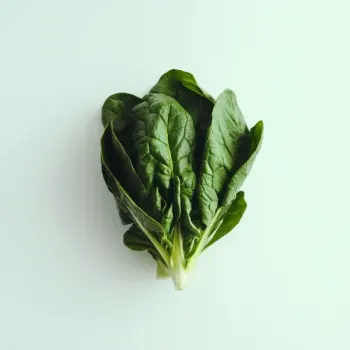Swiss Chard vs Spinach are two distinct leafy greens with differing flavors, textures, and culinary uses, each offering unique nutritional benefits and versatility in recipes from salads to sautés.

Swiss chard is a leafy green vegetable that is part of the beet family. It's known for its bright-colored stems and deeply grooved, large leaves. Swiss chard has a slightly bitter taste, which becomes milder when cooked.

Spinach is a versatile leafy green with tender leaves and a slightly sweet flavor when young, which can turn slightly bitter as the leaves mature. It belongs to the amaranth family and is widely used in a variety of cuisines.
Swiss chard has a more robust, earthy flavor and a firmer texture than spinach, which has a milder taste and delicate leaves that wilt quickly when cooked.
Swiss chard stands up well to longer cooking times, making it ideal for braises and stews, while spinach is better for quick sautés or as a fresh salad green.
Both greens are nutritious, but Swiss chard typically offers more vitamins K, A, and C per serving, whereas spinach provides more folate and iron.
Swiss chard tends to be more heat-tolerant than spinach, allowing it to be available for longer periods throughout the year. Spinach grows best in cooler weather and can bolt quickly in heat.

Your ultimate Recipe Box, Meal Planner, and Cooking Class all in one
Young Swiss chard leaves can be used in salads for a colorful and crunchy addition. They pair well with robust dressings and can hold up to heartier toppings like nuts and cheeses. Spinach is a classic salad green, known for its soft texture and mild flavor. It works well with a variety of dressings, from light vinaigrettes to creamy options, and complements ingredients like berries, goat cheese, and almonds.
The sturdy leaves of Swiss chard make it an excellent addition to soups and stews, where it can simmer for longer periods without disintegrating, adding a burst of color and nutrition to dishes like minestrone. Spinach is often added to soups and stews at the end of cooking to preserve its delicate flavor and texture. It's perfect for quick soups like chicken florentine or lentil spinach soup.
Sautéed Swiss chard, especially when the stems are included, adds crunch and a touch of bitterness to dishes. It's great in stir-fries, with garlic and a splash of vinegar or lemon juice to brighten the flavors. Spinach wilts quickly when sautéed, making it ideal for fast and simple side dishes. It's often used in stir-fries with garlic and can be finished with sesame oil for an Asian-inspired flavor.
Both Swiss chard and spinach are low in calories and high in essential nutrients, making them a healthy addition to any meal.
| Nutrient | Spinach ( per 100g ) | Swiss Chard ( per 100g ) |
|---|---|---|
| Fat | 0.4g | 0.2g |
| Protein | 2.9g | 1.8g |
| Calories | 23 | 19 |
| Vitamin A | 9377IU | 6116IU |
| Vitamin K | 483μg | 830μg |
| Carbohydrates | 3.6g | 3.7g |
Yes, Swiss chard can be used as a substitute in a spinach pie, but you may need to cook it slightly longer to achieve a similar texture.
Spinach is generally preferred for smoothies due to its mild flavor and softer texture, which blends more easily.
Spinach is more commonly consumed raw, as it has a more tender texture and a milder flavor compared to the slightly bitter taste of raw Swiss chard.
Both Swiss chard and spinach should be stored in the refrigerator. Wrap them loosely in a damp paper towel and place them in a plastic bag to retain moisture and freshness.
While you can cook these greens using similar methods, Swiss chard generally requires longer cooking times than spinach due to its tougher texture.